Rethinking rebar: Reinforcement goes green
by brittney_cutler | July 30, 2022 9:00 am
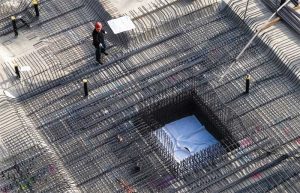 [1]
[1]Reinforcing bar, commonly known as “rebar,” comes in the form of mesh, wires, or bars, and is designed to strengthen concrete under tension. Describing it in a more humanistic manner, one could consider rebar as a part of the muscular skeletal system of a building. Together, rebar and concrete work to resist tensile forces and increase the utility of a structure. Without rebar, people would not be able to build high into the sky or safely cross large expanses of water. However, the embodied carbon generated while creating and transporting traditional rebar is substantial. Luckily, new alternatives to traditional reinforcement are becoming more present in the market and the steel industry is making strides to build more sustainably.
Steel rebar
Historically, reinforcement has come in the form of steel. Common on all manner of job sites, the basic “black” bar is carbon steel rebar. It has high tensile strength, but corrodes easily, making it a poor choice in matrices with high likelihood of moisture exposure. ASTM A615M-09, Standard Specification for Deformed and Plain-Carbon Steel Bars for Concrete Reinforcement, covers parameters for lengths and coils of various reinforcement.
Epoxy-coated rebar is basically standard steel rebar with a thin coat of epoxy. It offers improved resistance to corrosion; however, the epoxy coating itself is delicate and chips easily during transport or installation. This can leave affected areas susceptible to corrosion. Guidelines for rebar with protective epoxy coatings are covered in ASTM A775M-19, Standard Specification for Epoxy-Coated Steel Reinforcing Bars.
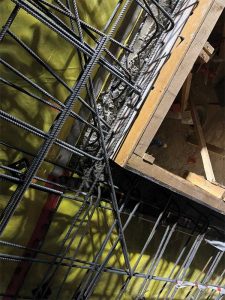 [2]
[2]Galvanized rebar fills a similar role to epoxy-coated rebar, by way of the galvanizing process. Compared to epoxy-coated rebar, galvanized varieties are not as resistant to corrosion, but they are more difficult to chip and damage. The coating material for galvanized rebar is zinc, which is applied in various thicknesses through a process called “dipping” or “hot dipping.” Bolts, ties, dowel bars, and anchors can all be galvanized.
Stainless steel rebar has significant resistance to corrosion and does not require mitigating chipped areas like epoxy-coated rebar. This makes it an optimal choice for ease of installation and durability of the reinforced concrete. However, stainless steel reinforcement is traditionally very expensive and typically only found in projects which require long-term defense against corrosion, such as bridges or in geographies with higher seismic activity[3]. It is also more embodied-carbon-intensive than standard rebar, by a margin of more than 10 percent.[4] In North America, the main standard for stainless steel rebar is ASTM A955/A955M, Standard Specification for Deformed and Plain Stainless-Steel Bars for Concrete Reinforcement. It includes dimensional bar profiles and other information to assist project teams.
While steel provides excellent strength, its Achilles’ heel is its embodied carbon footprint. A ton of steel is worth about a ton of greenhouse gas (GHG) emissions, approximately equivalent to the amount of carbon dioxide (CO2) burned in 40 home barbecue propane tanks. Steel also has a higher embodied carbon footprint (by weight) compared to concrete. According to information from the World Steel Association, steel production equates to six to seven percent of global GHG emissions[5].
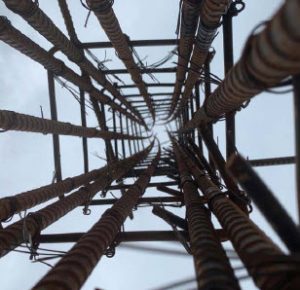 [6]
[6]The main driver of steel emissions is the production process. There are two primary types of factories: the basic oxygen furnace (BOF) and the electric arc furnace (EAF). Steel is an alloy of iron and carbon. Legacy BOF furnaces burn fossil fuels to heat iron ore, coke, and limestone to temperatures exceeding 2000 C (3632 F). This is then mixed with 25 to 40 percent iron and steel scraps to make new steel. Modern EAF furnaces melt iron and steel scraps to create new steel, achieving much higher recycled content rates of 90 to 100 percent. While EAFs have become the predominant form of steel[7] production in the U.S., BOFs are still the most common furnaces used around the world.
Given the high recycled content, steel from EAF production types tends to be about half as carbon intensive as BOF steel. However, reducing steel’s carbon footprint is not always as easy as specifying steel from an EAF factory, as production type is tied to steel shape. Hot rolled steel shapes, for example, are typically produced in EAF factories in the U.S. However, hollow structural section (HSS) shapes are more likely to come from BOF factories. Rebar can be produced using either BOF or EAF processes, thus sourcing rebar from EAF furnaces is preferred.
The efficacy of specifying higher recycled content as a method to reduce the embodied carbon footprint of steel has also recently been challenged. Since the amount of scrap steel available is limited, some experts suggest specifying a higher recycled content in metal products only arbitrarily changes the manufacturer’s allocation of accounting for scrap—shifting this benefit from one buyer to another, rather than creating any substantive change in supply chain practices. Until specifying higher recycled content starts to make steel deconstruction and recovery practices more desirable, and effectively adds more scrap to the system, it is challenging to create change through specifying higher recycled content.
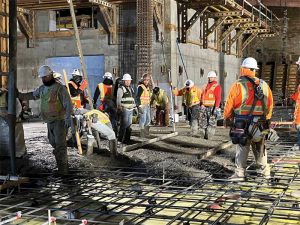 [8]
[8]Composite reinforcement
Composite rebar is not necessarily new, but it may not be as widely utilized as it should be. Unlike its steel cousin, composite rebar generally does not have any natural weakness to corrosion, which reduces the risk to the concrete around it. Composite reinforcement is also non-conductive, and in many instances, it has greater tensile strength compared to many types of steel rebar. Additionally, since composite reinforcement is lighter than steel, there are more benefits to the economic and carbon costs of its transportation.
There are two common types of composite rebar: glass fiber reinforced polymer (GFRP) rebar and basalt fiber reinforced polymer (BFRP) rebar. Fiberglass rebar is produced from glass fibers in a polymeric matrix. The polymer makes load transfer to the glass fibers possible, while the fibers themselves carry the load.[9] ASTM D7957, Standard Specification for Solid Round Glass Fiber Reinforced Polymer Bars for Concrete Reinforcement, provides guidance for GFRP in structural applications. The Canada Standards Association (CSA) also provides specifics on building with composite rebar in CAN/CSA-S806-12 (R2017), Design and Construction of Building Components with Fibre-Reinforced Polymers[10]. GFRP composite rebar is generally considered to be more carbon intensive than BFRP, 100 percent EAF recycled rebar, but less carbon intensive than stainless steel rebar, galvanized rebar, or standard BOF rebar. Basalt fiber reinforced polymer, sometimes known as “basalt rock rebar,” has higher tensile strength compared to steel and, like fiberglass, is non-corrosive. Basalt rebar also shares concrete’s same thermal coefficient of expansion and can be up to 89 percent lighter than steel, making its related carbon expenditures in transportation the lightest yet.
Research suggests the emissions from manufacturing BFRP rebar are 74 percent less than typical steel and 22 percent less than 100 percent recycled content EAF steel. Not only are composites lighter, and in some ways stronger than steel, but they also make sense in scenarios where water exposure is a risk to the long-term health of the concrete system.
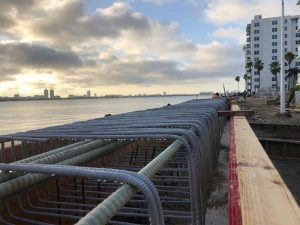 [11]
[11]One example would be using composite reinforcement in a concrete slab which will also have a hydronic heating system. Hydronic systems embed tubes into concrete, which will carry heated water to warm the slab. However, if there is a leak and the hydroponic tubing is tied to metal reinforcement, there is certainly a risk of corrosion. Basalt and fiberglass reinforcements do not corrode. While this does not necessarily prevent a leak from happening within the slab, it will reduce the possible damage the leak will have on the entire slab. Basalt and glass fiber rebar installation guidelines for composite reinforcement of concrete are defined in ACI 440.6-08, Specification for Carbon and Glass Fiber-Reinforced Polymer Bar Materials for Concrete Reinforcement.
As previously noted, steel and composite rebar do not have identical mechanical characteristics. While composite rebar may have greater tensile strength, it can also have a lower modulus of elasticity than steel rebar. This can limit its application in certain scenarios. It is therefore important to check with the project team’s engineers to ascertain best uses, as well as serviceability limit state (SLS) and any municipal design codes related to sustained loads.
European rebar, produced with large amounts of manganese, has tremendous flexibility and is easy to work with. But, this same workability also makes it unsuitable for bearing heavier loads, extreme thermal change, or the effects of seismic shock. However, it can be less expensive than traditional rebar[12] and have a smaller carbon footprint, making it potentially useful on smaller projects in areas with only subtle temperature swings.
Green steel
Composite rebar is certainly leading the pack when it comes to lowering embodied carbon in reinforcement, but this does not mean the steel industry is not pursuing other changes in the face of climate change. As previously described, newer electric arc furnaces are operating with far fewer emissions than older basic oxygen furnaces[13]. Along with modernization of many of the world’s electrical grids, the steel industry’s carbon[14] footprint has been reduced by 36 percent, according to the Steel Market Development Institute.
In the present market, specifying that suppliers must have product-specific Type III Environmental Product Declarations (EPDs), or specifying rebar producers who are already disclosing their impacts through EPDs are some of the best ways to support data transparency and data quality, and ultimately drive decarbonization in the steel industry. Sourcing rebar supplied from EAF mills is also advisable, as it will help support the transition to a greater share of EAF production over BOF-milled steel.
Several producers in the industry are also seeking to tackle the challenge of finding electric alternatives to the high-heat processes which make it so difficult to decarbonize steel production.
This includes exploring substitutes for traditional fossil fuels for driving high-heat processes, such as biomass-based fuels, or hydrogen-based production. [15]No doubt, more innovation in these markets and production technologies is a critical part of the decarbonization pathway.
A future with lower carbon steel starts with requiring EPDs for reinforcement products. Project teams should start to prioritize lower carbon products like composite reinforcement or EAF rebar in the earlier stages of planning and communicate with supply team partners to stay informed on best practices.
- [Image]: https://www.constructionspecifier.com/wp-content/uploads/2022/07/Photo-by-Ricardo-Gomez-Angel-on-Unsplash.jpg
- [Image]: https://www.constructionspecifier.com/wp-content/uploads/2022/07/ACI-360-Design-of-slabs-on-ground-provides-guidance-for-reinforcement-at-reentrant-corners-to-reduce-cracking.-Photo-Courtesy-of-Bennett-Build.jpg
- activity: https://link.springer.com/chapter/10.1007/1-4020-4891-2_21.
- 10 percent.: https://www.sciencedirect.com/science/article/pii/S0950061822011011.
- emissions: https://www.globalefficiencyintel.com/new-blog/2021/global-steel-industrys-ghg-emissions.
- [Image]: https://www.constructionspecifier.com/wp-content/uploads/2022/07/7-18-2022-10-18-03-AM.jpg
- steel: https://materialspalette.org/steel.
- [Image]: https://www.constructionspecifier.com/wp-content/uploads/2022/07/Photo-courtesy-Chris-Bennett-In-the-19th-century-the-invention-of-reinforced-concrete-revolutionized-how-the-built-world-would-be-designed.jpg
- load.: https://www.princeton.edu/~maelabs/mae324/glos324/gfrp.htm.
- Design and Construction of Building Components with Fibre-Reinforced Polymers: http://www.ictturkey.com/assets/images/can.csa.s806-02.pdf.
- [Image]: https://www.constructionspecifier.com/wp-content/uploads/2022/07/Photo-courtesy-Tuf-N-Lite-With-little-to-no-danger-of-corrosion-composite-rebar-is-an-ideal-material-for-reinforced-concrete-in-marine-coastal-regions.jpg
- rebar: https://theconstructor.org/practical-guide/steel-reinforcement-types-grades/24730.
- oxygen furnaces: https://www.hunker.com/13401389/basic-oxygen-furnaces-vs-electric-arc-furnaces
- steel industry’s carbon: https://cssbi.ca/blog/article-the-urgency-of-embodied-carbon-and-what-you-can-do-about-it.
- hydrogen-based production. : https://www.mckinsey.com/industries/metals-and-mining/our-insights/decarbonization-challenge-for-steel.
Source URL: https://www.constructionspecifier.com/rethinking-rebar-reinforcement-goes-green/
 Chris Bennett, iSCS, CDT, is CEO of a North American concrete consultancy that provides owner and designer representation, helping oversee documents and installation in the development of sustainable concrete solutions as well as risk and schedule reductions. Bennett has provided input to the National Research Council Canada for National Master Specification (NMS) content and is currently serving as president at the International Society for Construction Sciences (iSCS). He can be reached at bennettbuild.us.
Chris Bennett, iSCS, CDT, is CEO of a North American concrete consultancy that provides owner and designer representation, helping oversee documents and installation in the development of sustainable concrete solutions as well as risk and schedule reductions. Bennett has provided input to the National Research Council Canada for National Master Specification (NMS) content and is currently serving as president at the International Society for Construction Sciences (iSCS). He can be reached at bennettbuild.us. Aurora Jensen is a project manager and materials specialist in Brightworks’ office in New York, where she specializes in embodied carbon measurement and reduction strategies. She also has experience in operational carbon modeling and evaluating passive strategies, and helps clients link operational and embodied carbon considerations and evaluate trade-offs. Jensen currently sits on the steering committee for the Carbon Leadership Forum in
Aurora Jensen is a project manager and materials specialist in Brightworks’ office in New York, where she specializes in embodied carbon measurement and reduction strategies. She also has experience in operational carbon modeling and evaluating passive strategies, and helps clients link operational and embodied carbon considerations and evaluate trade-offs. Jensen currently sits on the steering committee for the Carbon Leadership Forum in